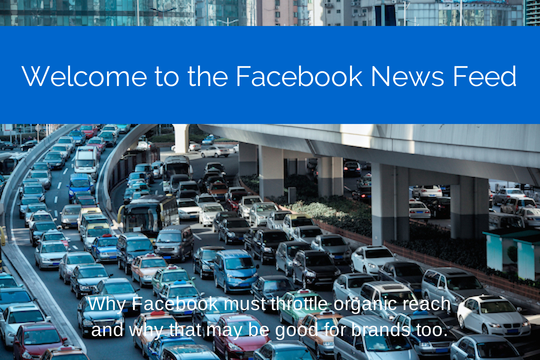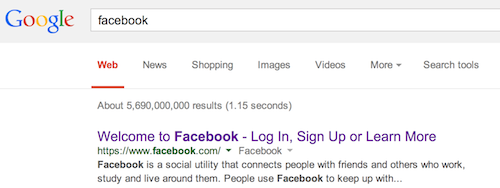Why Facebook’s Organic Reach Throttle May Be Better for Brands Than They Think
In this column, I will make a case that Facebook’s reduction of organic reach for brand pages is a win-win for both Facebook and brands. I will also assert that while Facebook’s throttling of reach is indeed an attempt to make more money, it’s not in the way you think. But to get there, we must […]
In this column, I will make a case that Facebook’s reduction of organic reach for brand pages is a win-win for both Facebook and brands. I will also assert that while Facebook’s throttling of reach is indeed an attempt to make more money, it’s not in the way you think.
But to get there, we must talk about traffic jams.

Growing up in suburban New Jersey just outside New York City in the ’70s, I was all too familiar with traffic jams. But it wasn’t until I started driving myself that I realized how much of the congestion was caused by roads that simply couldn’t handle the volume of automobiles trying to use them each day. (And that was without any fiddling around by the governor!)
My mother knew well the source of the problem because she’d grown up in the area. When she was a young girl pre-World War II, our town was mostly farms, and many of the side roads were still dirt, even though you could see the Manhattan skyline from the end of our street.
The main roads and highways were built for the much lower number of much slower vehicles around in those days. Then, post war, the entire area boomed like crazy. Factories, housing developments, and shopping centers sprang up, crowding right against the already-aging roadways. Planners were left with a real problem: how to manage the growing congestion of an ever-expanding population.
Today, social media networks face a very similar problem, and they have a solution: news feed filtering.
Facebook’s Growing Pains
Facebook is an excellent (and probably the best-known) example of news feed filtering. In some ways, the early days of Facebook were something like my old home town. Built for college students to keep up with their friends, the network didn’t even have or need a news feed. Most users followed a relatively small group of friends, and if you wanted to see what someone was up to, you visited their “wall.”
As the network was opened up to anyone, it began to grow rapidly, Facebook introduced the news feed. The news feed was a more efficient way to get updates on your friends. You got everyone’s status updates without having to visit all their walls.
As with just about any significant change to Facebook, there was an uproar of outrage at first. Some users didn’t like that friends no longer had to “drop by” for a visit. But once the utility of the news feed became apparent, the complaints stopped. The news feed, from then on, was Facebook as most people would know it.
Then, as we all know, Facebook became wildly popular. For many people, it was only a matter of years before Facebook virtually replaced all the individual websites and portals they used to bookmark and visit. It seemed like everyone had a Facebook profile, and more and more status updates flooded the news feed.
That was only the beginning, though. With that many eyeballs spending that much time in one place, brands and marketers wanted in — and Facebook wanted a chance at the money they could bring.
Thus Facebook Pages were born, and businesses could now create status updates that also became part of users’ news feeds. At that point news feeds began to resemble those pre-war highways in the New Jersey of my youth. More and more traffic on roads that were never designed to handle the volume. Most user news feeds began to flow too fast.

Enter The Brand Bonanza
As daily updates for many began to climb into the hundreds and beyond, there was no way the average user could see all, or even most, of what his or her friends were sharing. But it was to get worse.
Brands discovered that status updates pushed into followers’ news feeds were a powerful form of free advertising to a captive audience. Soon, more and more brand content began to compete for the same limited space and attention.
Such news feed clutter became a major concern for the bean counters at Facebook. So they slowly but surely began to tweak and filter what showed up in news feeds (and when, and how much, and from whom).
But why? Why should they care what happens in our news feeds? Why not let it flow and let the chips (or updates) fall where they may? We’ll return to that important question in a moment.
But first let’s look at a network that has steadfastly refused to mess with the feed.
The Facebook Throttle: Pushing It Forward
Facebook’s response to the ever-burgeoning news feeds of its users was to begin to filter them. This filtering has gone through several evolutionary steps, as detailed by Matt McGee here on Marketing Land.
First, Facebook manually tweaked aspects of the feeds in response to user feedback. People want to see more photos, so increase the preference for photo posts. People are concerned about too much branded content, so dial that back a bit.

This “knob turning” (as Facebook VP of Product Chris Cox called it in the McGee post linked above) was replaced by the famous EdgeRank. EdgeRank was Facebook’s first attempt at a more algorithmic approach to tuning news feeds, similar to the early days of Google’s PageRank. EdgeRank rated the relevance of potential content based on three main criteria:
- Affinity (how close is the relationship of the user to the content source?)
- Weight (how much engagement has the content received from other users?)
- Decay (how recent is the content?)
EdgeRank did provide more personalized news feeds for users, but it proved too easily gamed, especially via the “weight” category. As brands discovered that content that got more likes or comments was more likely to be shown to more users, they began a wild and sometimes irrational contest to get user engagement. Users’ feeds were being filled with absurd non-sequitur posts designed to do nothing more than garner likes or comments.
So Facebook began expanding and complicating the criteria of its news feed algorithm and, as McGee reported, haven’t themselves used the term “EdgeRank” for years now. While affinity, weight, and decay are still factors, many more complex factors and relationships now enter into what gets shown in a user feed, most of which we can only guess at.
The Facebook Throttle: Enhancement Or Revenue Grab?
Brands only began to notice that something had changed in Facebook’s algorithm as they realized their average reach (the percentage of their fans that actually potentially see each post) was steadily declining. Ogilvy & Mather reported that average reach had dropped from 12% in October 2013 to 6% by February 2014.
For pages with less than 500,000 likes, the reach was now as low as 2%.
Predictably perhaps, many brands that had worked hard to build large followings on Facebook were outraged, and some marketers called it a nightmare. In one well-publicized case, food site Eat24 published a “breakup letter” to announce its decision to close its Facebook page.
Some marketers and social media pundits alleged that this throttling by Facebook was based in pure greed. By throttling back organic reach, Facebook was trying to force more businesses to “pay to play” since a page could still get its content pushed out into user news feeds by paying Facebook for the privilege.
Indeed, Facebook fueled this impression when, in a leaked document intended to be seen only by some major brand partners, Facebook suggested that paid promotions on their network really were the best way to reach the Facebook audience.

Facebook’s Brian Boland
Facebook Finally Responds
In a June 5, 2014, blog post, Facebook’s VP of Ads Product Marketing, Brian Boland, wrote an extensive FAQ to answer questions about the reduction in organic reach. Admittedly, he probably didn’t help his case with the angriest of pages by reinforcing pretty much what the leaked document had said:
Like TV, search, newspapers, radio and virtually every other marketing platform, Facebook is far more effective when businesses use paid media to help meet their goals. Your business won’t always appear on the first page of a search result unless you’re paying to be part of that space. Similarly, paid media on Facebook allows businesses to reach broader audiences more predictably, and with much greater accuracy than organic content.
In other words, pay-to-play is and will be the most effective way to reach your audience directly on Facebook, at least for the foreseeable future.
Angry as it may have made some brands/marketers, however, the post also included one of the clearest explanations of why Facebook needed to restrain organic content from brands in news feeds.
Why Facebook Filters Feeds
Boland’s post reveals some interesting internal statistics about news feeds. He said that when the average user logs in, around 1,500 stories could potentially appear in their news feed. For users who follow a lot of people and pages, that figure can be as high as 15,000 potential stories.
Knowing that even 1,500 is more than anyone can absorb in a sitting, Facebook’s algorithms whittle that down to 300 that will actually make it into the feed. Those 300 are then ranked to decide which will be at the top (in the default “Top Stories” view).
Brands must also compete for placement within those 300 posts, but Facebook knew from its internal metrics that there were two strikes against showing a lot of brand updates:
- More and more branded content was being pushed at users as users are liking more pages than ever before (up 50% since last year), and brands struggling to compete for increasingly limited space share more content.
- Users spend less time on Facebook when too much branded content appears in their streams, even if that content is from brands they “liked.”
That last point is important. While users say they don’t want Facebook to filter their streams, Facebook knows otherwise. Keeping users truly satisfied is Facebook’s number one goal, as satisfied users spend more time on the site. And sometimes, satisfying a user means doing not what the user says he wants, but what his actual behavior shows he really wants.
This is where Boland’s analogy to search engines is particularly apropos.
How Facebook Is More Like Google Than You Think
For all the many differences between Facebook and Google Search, the similarities in what they need to accomplish are quite striking.

For both Facebook and Google, increasing user time-on-site is imperative. Why? Because both platforms are ultimately advertising delivery platforms. Advertising is their primary revenue source, and advertising only works when people see it. Therefore, the real purpose of both Facebook and Google is to create sites the user wants to return to again and again.
That need for eyeballs is what drives Google to invest incredible amounts of money and brainpower into constantly increasing the quality of its search results. If people time and again get satisfying answers when using Google Search, they will be highly incentivized to return.
For the same reason, Facebook must work hard to continually improve the quality of the experience of its users, and the primary battleground for user satisfaction is the quality of the news feed. Facebook must algorithmically filter the news feed because vast experience (and data) has shown them that a filtered news feed, using machine intelligence to try to anticipate what users will most enjoy seeing, produces happier users.
Happier users stay longer and keep coming back — and those users will be exposed to more ads, making Facebook more money.
Here’s where I’m going with this: both Facebook and Google must filter what their users see, and they both do it to make more money.
Why The Facebook Throttle Isn’t A Squeeze Play

Does Facebook have your brand in a squeeze play?
Now here’s the application I want to make to Facebook in particular: Yes, Facebook throttles brand page organic reach to make more money. But not in order to force brands to pay-to-play.
I believe that ultimately Facebook knows the most money is to be made not from forcing brands to buy more ads and promoted posts, but from providing more eyeballs for those ads and promoted posts.
That might sound like sleight-of-hand with words, but the difference is quite real and profoundly important for Facebook to “get” (as I believe they do).
It makes no sense to build a revenue model based on trying to force money out of brands against their will. But showing those brands that Facebook can provide them with a huge amount of impressions before a highly-targeted audience of happy users if they do fork over their cash — that makes a ton of sense.
If I’m right about that — and I believe I am — then the Facebook throttle, though a somewhat risky move insofar as it angers brands in the short term, will probably be a win-win for both brands and Facebook in the long run.
That’s because Facebook is right: In a social space where 1,500 to 15,000 content pieces compete for each user’s news feed every time the user logs in, targeted paid advertising or promoted content is a brand’s best bet. But that is only valid if those targeted people are around long enough to be exposed to the ads or promoted content.
So that’s why Facebook must obey its data. And these data tell them that the setup most likely to produce users who come more often and stick around longer when they do — users who are more likely to come into contact with ads or content exactly targeted to them — is one in which there is less organic branded content in those users’ feeds.
Hit Me Back — I Know You Want To!
I realize that for managers of brands with pages on Facebook, I’ve just stated what may be a controversial position. Let’s say it, I may have just made you very angry! I welcome your pushback, but I’m hoping to hear solid reasons why I’m wrong, reasons beyond, “Facebook is just greedy and hates businesses!”
Here’s what you need to show me in order for me to admit I’m wrong about this: make a case why it would make good business sense for Facebook to force brands to spend money they don’t want to spend. I think Facebook is smarter than that. But perhaps you can convince me otherwise. I welcome your comments!
(Stock images [three modified] via Shutterstock.com. Used under license.)
Contributing authors are invited to create content for MarTech and are chosen for their expertise and contribution to the search community. Our contributors work under the oversight of the editorial staff and contributions are checked for quality and relevance to our readers. MarTech is owned by Semrush. Contributor was not asked to make any direct or indirect mentions of Semrush. The opinions they express are their own.
Related stories
New on MarTech